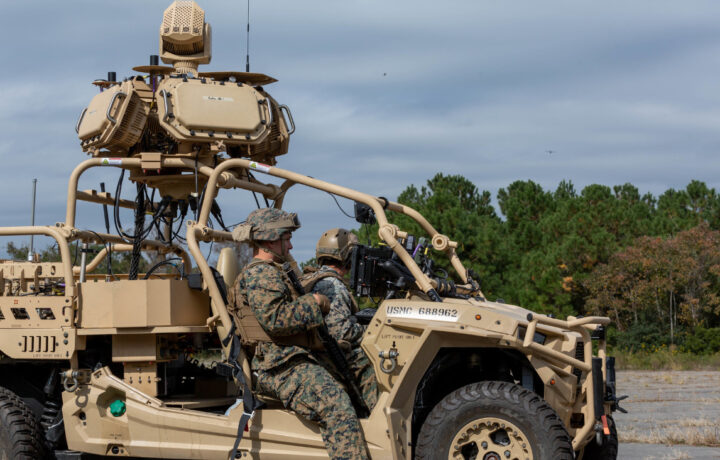Low-cost, off-the-shelf commercial unmanned aerial vehicles (UAVs) have proven to be a game changer in the war in Ukraine. Kyiv’s forces have modified these simple drones into capable killing machines that can drop ordnance onto a bunker, tank, or other vehicle with precision accuracy. In other cases, specialized “loitering munitions” – aka “kamikaze drones” – like the U.S.-made Switchblade and the Russian Lancet have been employed to seek out a target of opportunity and then strike like a missile.
The United States military has already been developing various tools to counter these small flying threats, and this has resulted in the Marine Air Defense Integrated System (MADIS), which is part of its new push for modernizing its Ground Based Air Defense (GBAD) capabilities. As part of the USMC’s Force Design 2030 modernization initiative, the Marine Corps plans to upgrade two of its active Low Altitude Air Defense (LAAD) battalions, which currently rely on dismounted Stinger missiles and radar equipment transported in two M1114 HMMWVs per section.
Mounted atop a 4×4 Joint Light Tactical Vehicle (JLTV), it is armed with turret-launched air defense weapons that can be used to detect and counter hostile low-flying helicopters and fixed-wing aircraft.
Getting MADIS
The USMC’s 2024 budget request includes more than $200 million for the service to purchase the MADIS, as well as to fund upgrades that could make them even more formidable against aerial targets.
The service seeks to acquire thirteen of the MADIS Increment 1 systems, which could be mounted on top of joint light tactical vehicles, at a cost of $130.2 million each. In addition, the Marine Corps could spend $24.6 million to retrofit seven previously procured systems with existing technology; and another $12.5 million for training and logistics. A further $8 million would be dedicated to procuring engineering change orders “required to ensure increased lethality against evolving threats,” according to a budget justification document.
The Block 1 JLTV-mounted MADIS system will be available in two variants. The Mk1, which was developed for airborne threats, is equipped with turret-launched and shoulder-fired Stinger missiles for mounted and dismounted ops, multifunctional electronic warfare capability, and an electro-optical infrared optic. The MK2, specialized for drone killing, includes multi-functional electronic warfare, 360-degree radar, and a command-and-control communications suite.
L-MADIS Explained
The United States Marines Corps also announced this month that by the fall of next year, its low-altitude air defense battalions will begin to receive the Light Marine Air-Defense Integrated System (L-MADIS), a light vehicle-mounted platform that can help mitigate threats by disrupting the electronic signals between the drones and its controller.
The L-MADIS is small enough that it can be transported in a sling below an H-53 helicopter.
The L-MADIS can be mounted to a pair of light and compact Polaris MRZR frames, which allow the system to be deployed to austere environments via air transport. One Polaris MRZR can act as a brain for the system – and it is equipped with the CM262U optic, which acts as the ‘eyes’ of the system. It is also fitted with the RPS-42 radar and Skyview MP, which provide 360-degree air surveillance and long-range drone detection.
The second Polaris MRZR can carry the Modi II, which is a dismountable electronic-warfare system that can be employed to disrupt enemy drones and communications. In addition, the L-MADIS utilizes the AN/PRC-158 multichannel manpack radio system, allowing the platform to communicate everything it detects to troops in its immediate vicinity and commanders in the rear echelon.
The 2024 budget request calls for $32.5 million for L-MADIS procurement, including $23 million for five L-MADIS systems while the remainder is for logistics, labor, and training.
Prior to fielding, several MADIS and L-MADIS systems already are operating in the fleet. According to the Marine Corps Times, the operational debut of MADIS came in July 2019, when its light version, or L-MADIS, mounted on a variant of the Polaris MRZR all-terrain vehicle shot down an Iranian drone while deployed aboard the amphibious assault ship Boxer. That particular mission came just a month after Iran downed an expensive U.S. Air Force RQ-4 Global Hawk; and it served to highlight the transportability and effectiveness of the MADIS family of systems in a real-world threat environment.



